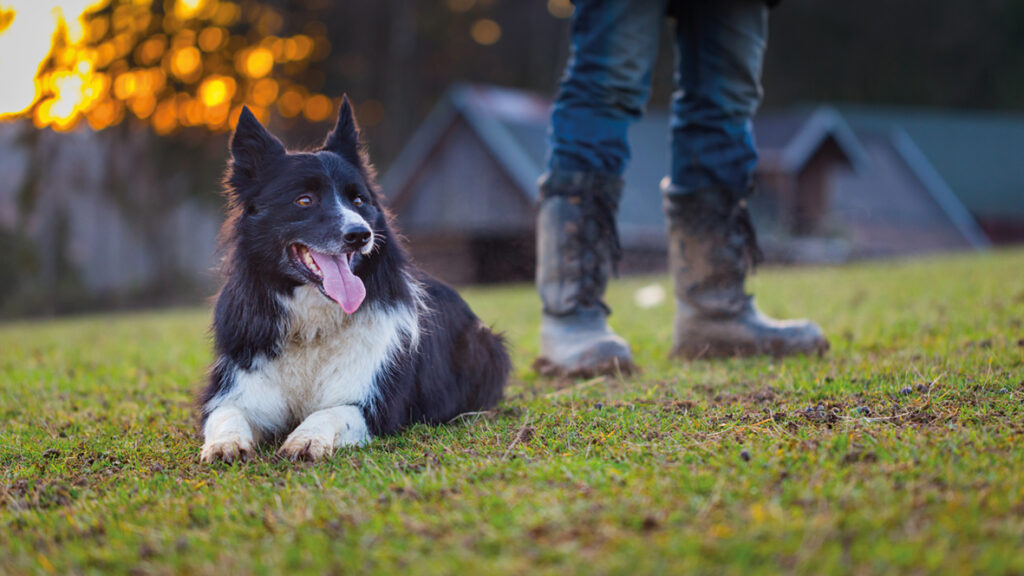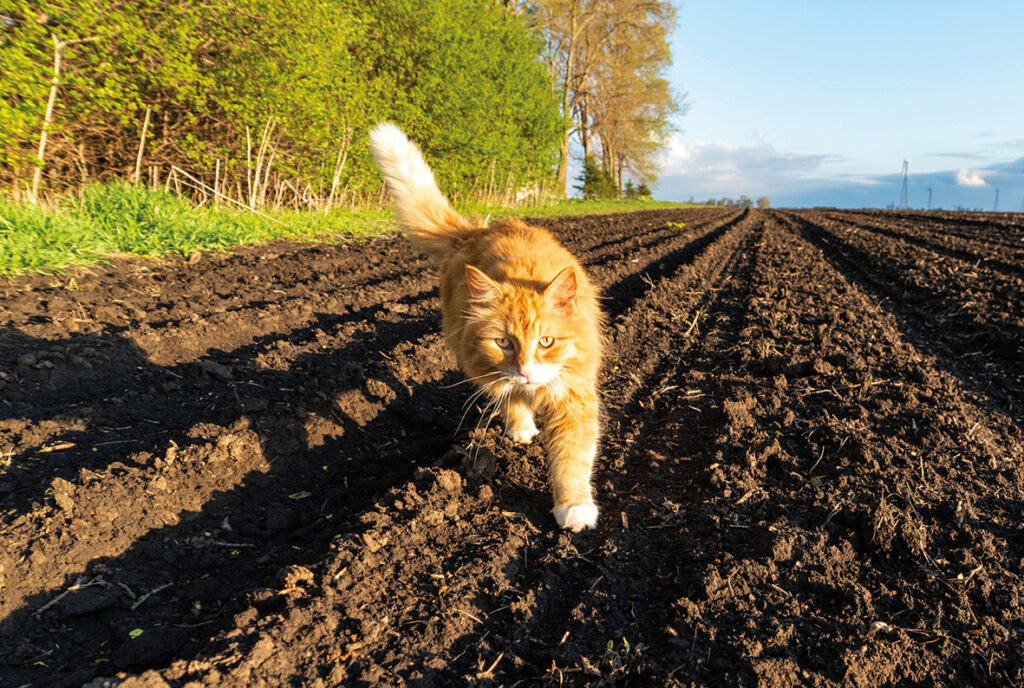Key health threats to farm dogs and cats
1st June 2022
While much time and expense goes into healthcare for livestock, it’s important not to forget the health of farm dogs and cats. Norbrook’s companion animal veterinary advisor Lars Mortensen outlines some health risks to be aware of.

Osteoarthritis
Farm dogs are generally much more athletic than family pets and therefore unlikely to be overweight – however, due to the nature of their daily activities they could be at more risk of developing osteoarthritis.
Osteoarthritis is a degenerative joint disease but early diagnosis, treatment and management changes can relieve pain and slow progression. It’s important to be able to spot the early signs to improve welfare and extend the working life of the dog.
A preventative approach is recommended, Mr Mortensen says. It is likely that dogs are doing things on a day-to-day basis that are not necessary for the farm, including jumping up and over obstacles that are too high and running through gates that could injure them or force them to move awkwardly. This can have a negative impact on the joints and should be minimised. “As long as it doesn’t interfere with the working role of the dog, if you can avoid those behaviours, you might have an active dog for longer than you would otherwise,” he explains. It’s a different story in cats – it’s very unlikely that you’ll be able to moderate their activity.
Signs of arthritis in dogs:
- Stiffness on getting up in the morning or after a break
- Slowing down/needing more rests throughout the day
- Reluctance to jump or perform tasks they did easily before
- Panting more
- Physically lame/repeated cases of lameness, especially on a specific leg.
Cats display similar signs, and in the early stages you may notice they are less active. If these signs are observed or you are concerned your animals could have osteoarthritis, speak to your vet about treatments and interventions. A range of products are available, in tablet, liquid or injectable forms.
A key challenge in working dogs after diagnosis is getting them to slow down while still keeping them active with a feeling of being a part of the ‘team’. “In a way you want to keep the dog moving, keep it active, but also you want to try as much as you can not to speed up or aggravate the progression of osteoarthritis. I would say it’s not necessarily the best thing to just stop working the dog, but instead use the dog more cleverly to reduce the strain and accept that it needs more rest and maybe shouldn’t be used for the most strenuous work anymore.
“Decisions should really be made on a case-by-case basis – this discussion is best had between the family, colleagues and the vet, because actions taken will depend on the degree of arthritis at diagnosis and the dog’s specific day-to-day working life. Once diagnosed with arthritis, the working dog should, in general, have an easier life than previously.”
Parasites
Lungworm: As lungworm is now endemic across the UK, it is recommended that all dogs and cats be given preventative treatment for this deadly disease. The farm dog is expected to be at higher risk as they are free-roaming and likely to come into contact with areas frequented by foxes, which are a reservoir animal for lungworm. Lungworm can cause signs ranging from a mild cough to heart problems and serious bleeding disorders.
Mange: Also a risk for farm dogs, this can be spread through direct contact with foxes – transmission can occur when a dog rolls in the hair or skin of an infected dead fox. It is rarer in cats; perhaps because they are less likely to engage in this behaviour.
Fleas and worms: Most farmers will treat regularly for fleas and lice, but if you choose a product wisely, it is possible to also cover other parasites such as lungworm and mange mites with the same treatment.
Ringworm: A fungal infection of the skin which is also fairly common on farms, especially in youngstock. As a zoonosis it can transmit to humans too. Dogs are more commonly affected than cats. There is no preventative treatment for ringworm in dogs and cats so treatment is tailored to each individual case.
Neospora caninum: This is a protozoan parasite which develops in the intestine of dogs and foxes. Once infected, the parasite eggs (oocysts) are shed in dog/fox faeces and cattle become infected either by ingesting parasite eggs at pasture or from contaminated feeds or water. Neospora is a common cause of abortion or stillbirth in cattle. A calf from an infected cow can also be born as normal but with a congenital infection that means it is not suitable for completing a full-term pregnancy.
Neospora infection in cattle cannot be cured but the risk of spreading it in the herd can be reduced by prompt disposal of placentas, aborted foetuses and stillborn calves. Dogs and foxes should not be allowed contact with these materials as this will increase the risk of the dog getting infected, thereby completing the parasite cycle.
Clinical signs are mainly seen in dogs under six months old and include muscle pain and neurological signs. Abortions and congenital infections are also seen in breeding bitches. In dogs, the condition can be treated with antibiotics but there is no treatment available for cattle so prevention remains the best option.
Toxoplasma: This is the second most commonly diagnosed cause of abortion in sheep in the UK. However, unlike Neospora, it is a zoonosis and cats are the definitive host. Kittens become infected when ingesting their prey. Oocysts are shed in the faeces and sheep become infected either by ingesting the parasite eggs at pasture or from contaminated feeds or water.
The infection cannot be treated, but there is a vaccine to prevent congenital toxoplasmosis in sheep. Immunocompromised individuals and pregnant women should avoid contact with cat faeces and ewes at lambing time.
Young cats are the highest risk for transmitting toxoplasmosis so maintaining a stable adult neutered population of cats on the farm is important. These may keep young cats out of the area and can of course help with vermin control.

Other factors to consider
Hard ground: There is often tremendous strain on working dogs’ paws and pads so it is worth considering the ground conditions the dog is working on. High intensity work on concrete or work areas with lime or urea can lead to dermatitis and blisters on the pads and paws, which can be incredibly sore.
Heat stroke: Working dogs are not good at considering the temperature, so it falls to us to regulate their work so it fits in with the temperature and humidity of the day. It is important to provide plenty of water and time in the shade to cool down on warmer days.
Leptospirosis: A zoonotic bacterial infection that can cause a range of serious problems including kidney failure. Leptospirosis can be picked up by dogs and cats through contact with soil or water which is contaminated with urine from infected animals such as mice, rats and cows. The bacteria is therefore more likely to be present in the farm environment. Prevention by annual vaccination is important.
Hyperthyroidism: This should be considered in the farm cat. It is not an uncommon condition and is more prevalent in cats over the age of 10. Affected animals produce too much of the hormone thyroxine, which is in charge of regulating the cat’s metabolism. Signs may include weight loss, increase in appetite, vomiting, hyperactivity and a change in behaviour. It is very easily diagnosed and treated in most cases.
On-farm hazards
With increasing attention on farm safety, it’s important to remember the hazards to farm cats and dogs too, including:
Machinery: Be very careful with dogs around farm machinery – particularly when jumping onto and off quad bikes, in and out of tractors and especially when mowing grass. While cats’ behaviour is difficult to control, dogs can be trained not to go near machinery unless they are instructed to and this may prevent serious or fatal accidents.
Workshops, feed and medicine stores: These should be kept secure and locked if possible so animals can’t wander in and out and gain access to hazards, such as: dangerous equipment, pesticides, herbicides, oils, medicines, antifreeze and feed supplements. In sufficient quantities, feed supplements such as minerals and vitamins could be toxic. Sweet feeds in feed stores can also cause gastrointestinal upset or other issues if ingested.
Access to rodenticides must also be prevented, and spillages of parasite treatments and other chemicals must be cleared up immediately to avoid contact and ingestion. Macrocyclic lactones in particular can be highly toxic or even fatal, with some border collies having a genetic mutation that makes them especially sensitive. As well as stored medicines, take care to prevent dogs having contact with or ingesting medications when they are administered to livestock. Occasionally drenches and boluses can be regurgitated and dogs can find these afterwards. Some can be very dangerous to dogs.
For further advice on farm dog and cat health and treatment options, speak to your vet.
